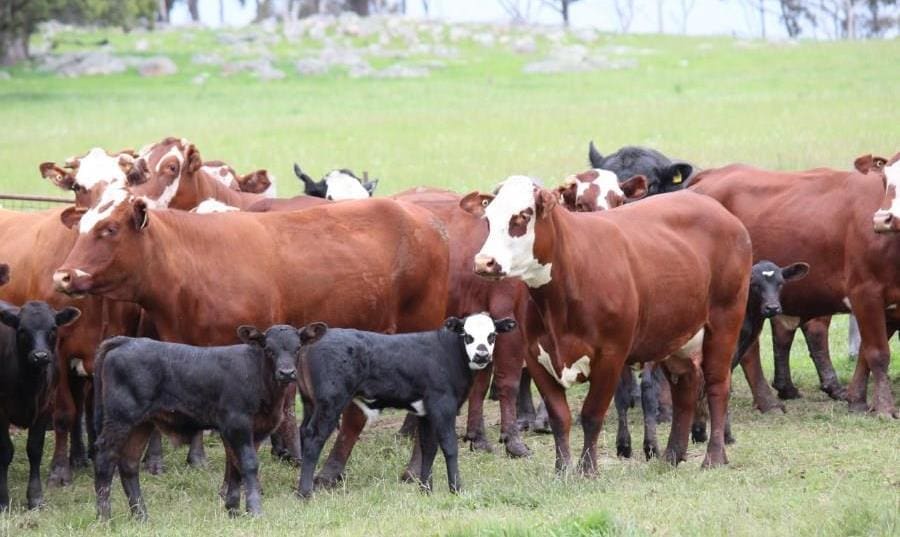
AN innovative new livestock finance product, designed specifically for breeding cattle and sheep has been released to the market – at a time when the livestock industry approaches a long rebuilding phase from national herd and flock sizes at 25-year lows due to drought.
Specialist livestock financier StockCo has been working on development of its breeder finance solution for some years. Its launch this month takes on heightened significance, given recent drought and flood impact across eastern Australia.
 Up to now, StockCo’s livestock finance packages have principally been focussed on the purchase of sheep and cattle for backgrounding, finishing or trading purposes, with facilities available to finance stock in feedlots or on pasture for up to 12 months.
Up to now, StockCo’s livestock finance packages have principally been focussed on the purchase of sheep and cattle for backgrounding, finishing or trading purposes, with facilities available to finance stock in feedlots or on pasture for up to 12 months.
“Australia’s livestock producers will need access to significant amounts of capital to restock following a prolonged period of drought conditions across much of Eastern Australia. StockCo has developed an innovative breeder funding solution for cattle and sheep, that will enable producers to access 100% financing solutions for breeding stock” StockCo’s General Manager of Agency, Tim Pryor told Beef Central.
“We’ve had a lot of enquiry from producers seeking a finance solution that funds 100pc of the purchase price and allows that breeding animal to be repaid progressively over 3 or 4 years.”
StockCo’s announcement regarding it’s breeder funding solution comes after the company last year announced settlement of a $150 million securitisation facility through Goldman Sachs (click here to view earlier story).
StockCo proposes to fund breeding stock for an initial term of 12 months – as it does now with trading cattle, paying 100 percent of the purchase price and carrying all of the finance cost so that there is no requirement for cash repayments in the first 12 months. At the end of the first 12-month cycle, the accrued finance costs and a partial repayment of the original purchase price are due, with the balance extended out for a further 12 months. This process could continue to be repeated over a 3 or 4 year period, allowing StockCo’s customers to progressively repay the breeding stock over a manageable period.
Recognition of slow cash cycle
Another unique aspect of the new breeder loan product is its recognition of the long cash cycle applying to productive females.
“In reality, there is anywhere from twelve months to two years after purchase before progeny are ready to sell, by the time the female is perhaps bought PTIC, calves down in another 3-6 months, and delivers a weaner ready to sell,” Mr Pryor said.
“Our strategy is to match up our requirement for a cash payment with the actual flow of cash through the customer’s business,” he said.
StockCo has been working on the new stock finance product development for some time – admitting it had been ‘challenging’ to secure a funding platform that would accommodate the breeder financing requirements in a way that best suited their customers requirements.
“Most main stream funders view livestock as a somewhat esoteric asset class and it takes time and a lot of interaction to help the global banks understand that livestock finance portfolios represent an excellent risk if properly managed and supported by appropriate governance frameworks, processes and IT systems ,” Mr Pryor said.
“StockCo’s approach is to provide our funders with the comfort they need, in a sensible way, matching the exposure to the growth in the value of the underlying collateral,” he said.
The breeder lending product is believed to be the first of its type in Australia, and there are no direct equivalents to be found overseas, StockCo believes.
“There are leasing products and the like already in the market, but they have very different repayment structures, requiring monthly, quarterly or half yearly principle and interest payments, and these payment structures often don’t suit a livestock producers cash cycle,” Mr Pryor said.
Building capacity to quickly restock after drought
Mr Pryor said one of StockCo’s key strengths was its innate understanding of the livestock industry, understanding how customers’ operations worked, on the ground. “We’re very much aligned with their thinking.”
He used a scenario were a producer who is emerging from a drought after three or four poor years, their breeder herd is depleted, and they have perhaps kept a core breeder herd a little longer than they should have, hoping the season would break before it actually did, meaning their working capital was often depleted.
“The banks have played a critical role and have assisted as much as they could, but they have to work within certain parameters. Coming out of a drought with significant pasture reserves, their ability to quickly restock using normal bank facilities is constrained,” he said.
“That’s not a criticism of the banks – it’s just a fact of life, under current lending policies, how they work, and the regulatory environment.”
“While StockCo, equally, must act in a responsible manner, our approach is very much around how we can provide a solution that gets customers back on their feet quickly after drought, without causing major disruptions to their working capital and cash flow position”
If a producer went to a bank and negotiated a five-year term loan to purchase a line of breeders, on month one, there is a principal and interest payment to make, and again in month two, three and four. But the borrower has no income for 12-18 months.
“It’s made what is already a difficult working capital position worse,” Mr Pryor said.
“StockCo’s view is that we will get the customer into those stock, get them building wealth by putting progeny on the ground and building value, and not ask the customer for any funds from those stock for 12 months.”
Mr Pryor said the producer could decide to sell older cows rather than re-mate them, reducing the StockCo facility, and then buy back in a younger productive animal that was in-calf or with calf at foot. The flipside to that could be a producer who had a particular genetic line they were determined to preserve, where StockCo could provide a cash advance against heifers bred on farm, to free-up working capital to allow them to be retained and taken through the process as part of the normal breeder funding program.
“In twelve months’ time, on the basis that the cattle have a reasonable season in front of them, are performing well and there is another round of progeny coming through, Stockco will provide it’s customers with a pathway to extend that facility for another 12 months on the same animal, and step down the exposure.”

Greg Noonan
Asked whether such a process involved more interaction between lender and borrower, Greg Noonan, general manager of product and distribution, said any existing StockCo customer would acknowledge that they ‘talk to StockCo much more than they talk with their bank.’
“The nature of our funding is that it is quite intensive. We have a lot of interaction with our customers, and tend to have a really thorough understanding of their requirements, their business, and how it works.”
Asked whether the new breeder facility was suited to both large, extensive northern operations and more intensively-managed smaller herds further south, Mr Noonan said the product had application right across Australia.
“Our key focus is in those proven, well-established livestock production areas, and certainly we’re comfortable to play in the bigger more extensive areas as well. For example we played a part in assisting some of those people affected by the February 19 flood events in northwest Queensland to restock.”
Interest rates
Mr Noonan said interest rates applicable to the new breeder loan would be set on a case-by-case basis.
“Like any other responsible lender, we will be conducting an assessment of the overall risk of the customer, and as we work through that, it will be reflected in the finance rate applied.
A key difference between StockCo’s breeder finance package and bank lending is that the StockCo model does not require a mortgage.
“A customer can generate a far higher return on the capital that StockCo provides, compared with a bank. While the cost of that capital might be a little higher, the return that can be generated, relative to bank funding, is much higher,” Mr Noonan said.
He used an example of a producer running 500 breeders, who is funded into another 500 breeders under the StockCo model.
“On the basis that a large part (or all) of the fixed cost base is already being met by the first 500, then essentially on those additional financed stock, the gross profit is net profit. The actual return that flows back into the producer’s pocket, after they have repaid StockCo, is a significant return.”
“We have proven with our model that customers who use StockCo in conjunction with their traditional bank are able to generate a far higher level of return on their overall asset base than they could by using bank funding alone.”
StockCo’s breeder funding solution is targeted at helping producers recover from a drought event, for example, and also assisting progressive producers looking to expand, seeking to grow the size of the operation following a recent property purchase or major capital expenditure program which lifted carrying capacity.
“We’re an ideal fit to work with them and their bank. The bank might fund the client into extra country, or they might go and lease some country, and we can get them into the stock to grow their business. What StockCo can do is bring forward that rate of growth for that customer,” Mr Noonan said.
“Our focus is on dealing with existing, well-established producers who have a track record of performance. They might have been impacted by seasonal or market conditions, but fundamentally they have a sound business with a sound history behind them.
“We’re also comfortable working with those producers who see trading opportunities, and are opportunistic in their approach – turning it on when seasons and circumstances allow, and paying us out when the opportunity diminishes, to wait for the next opportunity.
Will demand for breeder finance be cyclical?
Asked how cyclical demand for the breeder product was likely to be, Mr Noonan agreed that it was likely to vary over the seasonal cycle – “to a certain extent.”
“There’s obviously a real demand for it right now, and the industry, for the next three or five years is definitely going to be in a herd rebuild phase. But we’d expect that as the national herd gets back to more ‘normalised’ patterns, that demand will decline somewhat.
“But equally, more producers now are starting to realise that they can put our capital to work, and get a better result for the longer term – regardless of seasonal cycles. It may well be that we become a more permanent part of the capital structure of the Australian livestock industry than we have been to date.”
The reality is that droughts do occur reasonably frequently and are part of the natural cycle livestock producers operate within, so on that basis StockCo does see a reasonably consistent longer term demand for their breeder financing solution.
